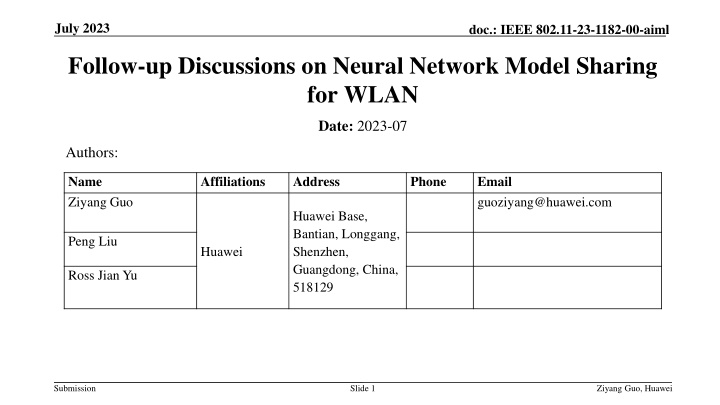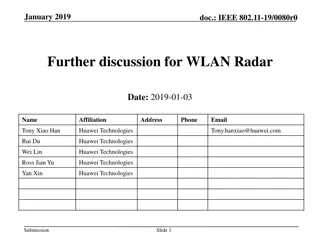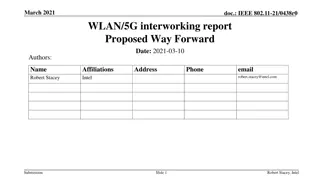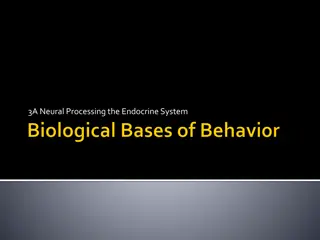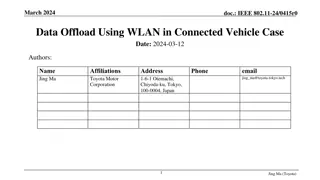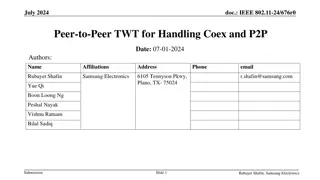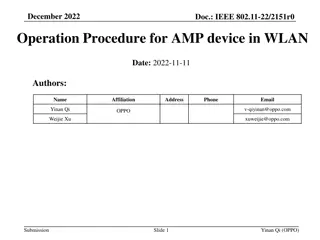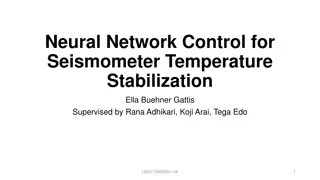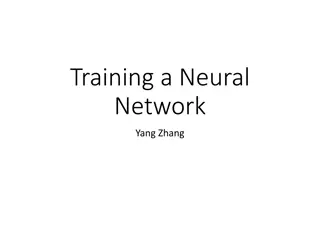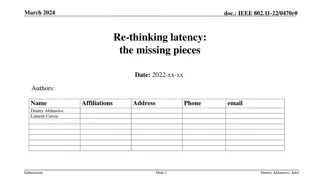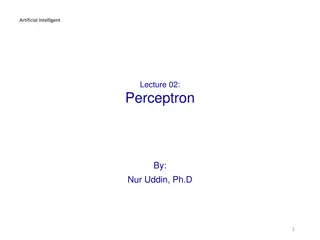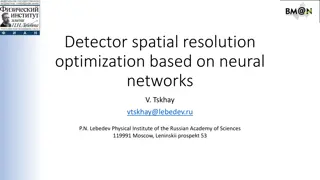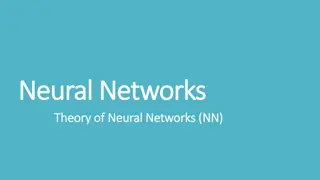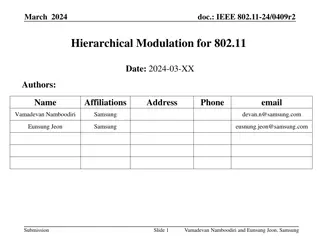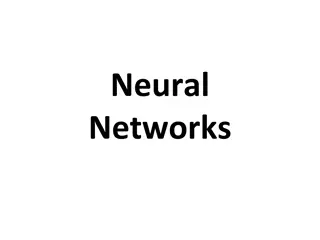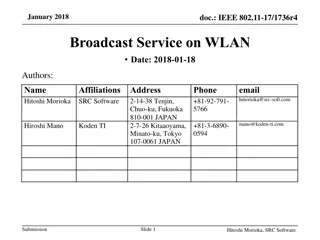Neural Network Model for WLAN Transmission Optimization
This document delves into the neural network model architecture for optimizing WLAN transmission schemes, focusing on channel access and rate adaptation. It explores components like pre-processing, core neural networks, and post-processing, discussing standardization considerations and model reuse feasibility.
Download Presentation

Please find below an Image/Link to download the presentation.
The content on the website is provided AS IS for your information and personal use only. It may not be sold, licensed, or shared on other websites without obtaining consent from the author.If you encounter any issues during the download, it is possible that the publisher has removed the file from their server.
You are allowed to download the files provided on this website for personal or commercial use, subject to the condition that they are used lawfully. All files are the property of their respective owners.
The content on the website is provided AS IS for your information and personal use only. It may not be sold, licensed, or shared on other websites without obtaining consent from the author.
E N D
Presentation Transcript
July 2023 doc.: IEEE 802.11-23-1182-00-aiml Follow-up Discussions on Neural Network Model Sharing for WLAN Date: 2023-07 Authors: Name Ziyang Guo Affiliations Address Phone Email guoziyang@huawei.com Huawei Base, Bantian, Longgang, Shenzhen, Guangdong, China, 518129 Peng Liu Huawei Ross Jian Yu Submission Slide 1 Ziyang Guo, Huawei
July 2023 doc.: IEEE 802.11-23-1182-00-aiml Introduction In [1], we revisited the use cases in the previous submission and observed that most of them can be regarded as transmission scheme optimization. Then, we investigated the neural network model architecture on transmission scheme optimization, which consists of inputs, pre-processing, core neural network and post-processing, and discussed the functions and possible standardization impacts/ways for each part. In this submission, we take channel access and rate adaptation as example. We study the technical feasibility of model reuse, i.e., a model with the same architecture is able to perform well on both tasks. Submission Slide 2 Ziyang Guo, Huawei
July 2023 doc.: IEEE 802.11-23-1182-00-aiml Recap: Neural Network Model Architecture[1] Components Descriptions Thoughts on Standardization Train@AP Standardize some basic and common inputs for a variety of use cases Input local radio measurements at PHY/MAC layer, defined in Sec.4.3.11 of 802.11-2020 or customized A sequence of historical observations AP1 AP Training data report Model deployment/sharing If Pre-processing is left for implementation, the output of Pre-processing (i.e., the input of core NN) shall be standardized Pre- processing Format conversion (e.g., normalization) to NN friendly format Feature extraction or augmentation Could be NN or other algorithms Non-AP 3 STA3 STA3 Non-AP 1 Inference@non-AP STA Non-AP 2 STA3 Standardize several basic and mandatory model structure such as DNN and CNN Alternatively, consider ONNX[6] or NNEF[7] on top of the 802.11 Explore model reuse Core Neural Network Structure, e.g., DNN or CNN Layer types, number of layers, number of neurons per layer, activation function Both types can be considered to be standardized Post- processing Map neural network output to specific transmission scheme Probability distribution or ArgMax Output/ decision Pre- processing Input/ measurements Post- processing Core Neural Network Submission Slide 3 Ziyang Guo, Huawei
July 2023 doc.: IEEE 802.11-23-1182-00-aiml Pre- and Post- Processing for Channel Access and Rate Adaptation Pre-processing could be normalization operation, i.e., the inputs are normalized before feeding into the Core Neural Network Model. Post-processing could be ArgMax operation, ?? denotes the sore for each action Rate Adaptation Channel Access ?0 ?1 ?0 post- post- Channel access decision MCS decision processing ?1 processing ?? 1 ?? is the output of the neural network, which corresponds to the score of using MCS ? post-processing unit selects the MCS with maximum score post-processing unit makes channel access decision according to s0 and s1, if ?0 ?1, transmit; else, wait Submission Slide 4 Ziyang Guo, Huawei
July 2023 doc.: IEEE 802.11-23-1182-00-aiml Core Neural Network Model for Channel Access and Rate Adaptation ?0 ?0 ?1 ?1 ?N 1 ?? 1 Input layer Output layer Hidden layer Given pre- and post- processing, the whole architecture can be simplified as a core neural network. The core neural network consists of input layer, hidden layer and output layer. The M-dimensional input layer is the a combination of input measurements after pre-processing and the N-dimensional output layer is score for each transmission scheme. Submission Slide 5 Ziyang Guo, Huawei
July 2023 doc.: IEEE 802.11-23-1182-00-aiml Inputs for Channel Access and Rate Adaptation Input dimension M Use case Input ??, ,?? ? ?? ? Meaning of the input Channel access [2][3] 32=3*10+2 ? is the carrier sensing result ? is the transmission action ? is the time that (?,?) lasts ?0 is the time since last successful transmission ?1 is the time since last successful transmission by others ?? 10,?? 10,?? 10, , ?? 1,?? 1,?? 1,?0,?1 ?? ? ? ?? ? Rate adaptation [4] 40=4*10 ?? 10,???? 10,RSS? 10,?? 10, , ?? 1,???? 1,RSS? 1,?? 1 ?? ? ? is the MCS selection ??? is the transmission result ??? is the received signal strength ? is the time since last transmission It can be observed that the M-dimensional input may contain a series of historical observations and some instantaneous observations, which can be expressed in the form of (historical observations) * (history length) + instantaneous observations, i.e., {??, ,?? ?} = {?? ?, ,?? ?,?}, where ? and ? represent historical and instantaneous observations, respectively. Submission Slide 6 Ziyang Guo, Huawei
July 2023 doc.: IEEE 802.11-23-1182-00-aiml Model Reuse for Channel Access and Rate Adaptation We found that [5], which also focus on AI-aided channel access as [2][3], adopts the same hidden layer as [4]. We replace the hidden layer used in [2][3] by that in [4], and investigate the feasibility of model reuse for channel access and rate adaptation. Use DNN-based hidden layer structure for both channel access and rate adaptation use cases Submission Slide 7 Ziyang Guo, Huawei
July 2023 doc.: IEEE 802.11-23-1182-00-aiml Model Reuse for Channel Access and Rate Adaptation The simulation results show that similar throughput and delay performance can be achieved by replacing hidden layer structure of channel access [2][3] by that of rate adaptation [4]. The same core neural network can be used for different transmission scheme optimizations. Original structure Model reuse Submission Slide 8 Ziyang Guo, Huawei
July 2023 doc.: IEEE 802.11-23-1182-00-aiml Discussions on Benefits of Model Reuse Reduce implementation complexity Avoid model compilation at the STA side Reduce developing effort and cost, e.g., memory for model storage Facilitate standardization Simplify the signaling of model alignment Easy for model management compared with one model for one feature AP STA Training Model (weight/bias, function ID, input/output indications) Taking channel access and rate adaptation as examples, training is performed at AP side. After training, model parameters (weight/bias) and other parameters (function ID, input/output indications) are sent over-the-air. STA updates the model accordingly. Function ID is used to indicate which transmission scheme (channel access or rate adaptation) the model parameters is associated with. Update model accordingly Submission Slide 9 Ziyang Guo, Huawei
July 2023 doc.: IEEE 802.11-23-1182-00-aiml Summary In this contribution, we take channel access and rate adaptation as example to further discuss the neural network model architecture, including Pre- and post- processing Inputs and reference format Technical feasibility of model reuse and corresponding benefits Submission Slide 10 Ziyang Guo, Huawei
July 2023 doc.: IEEE 802.11-23-1182-00-aiml Reference [1] 11-23-0750-00-aiml-discussions-on-neural-network-model-sharing-for-wlan [2] 11-22-1522-01-drl-based-channel-access [3] Z. Guo, Z. Chen, P. Liu, J. Luo, X. Yang and X. Sun, "Multi-Agent Reinforcement Learning-Based Distributed Channel Access for Next Generation Wireless Networks," in IEEE Journal on Selected Areas in Communications, vol. 40, no. 5, pp. 1587-1599, May 2022, doi: 10.1109/JSAC.2022.3143251. [4] W. Lin, Z. Guo, P. Liu, M. Du, X. Sun and X. Yang, "Deep Reinforcement Learning based Rate Adaptation for Wi-Fi Networks," 2022 IEEE 96th Vehicular Technology Conference (VTC2022-Fall), London, United Kingdom, 2022, pp. 1-5, doi: 10.1109/VTC2022-Fall57202.2022.10012797. [5] L. Zhang, H. Yin, Z. Zhou, S. Roy and Y. Sun, "Enhancing WiFi Multiple Access Performance with Federated Deep Reinforcement Learning," 2020 IEEE 92nd Vehicular Technology Conference (VTC2020-Fall), Victoria, BC, Canada, 2020, pp. 1-6, doi: 10.1109/VTC2020-Fall49728.2020.9348485. [6] Open Neural Network Exchange (ONNX), https://onnx.ai [7] The Khronos NNEF Working Group, Neural Network Exchange Format , https://www.khronos.org/registry/NNEF/specs/1.0/nnef-1.0.5.html Submission Slide 11 Ziyang Guo, Huawei
